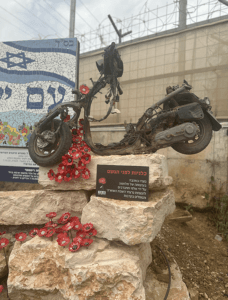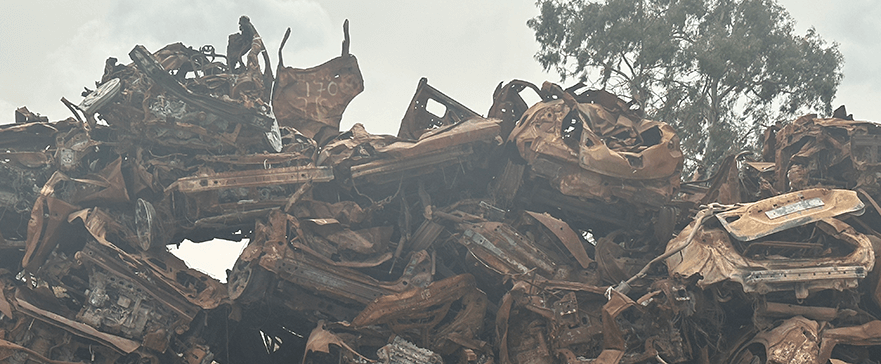I could hear the bombs rumbling in the distance as we approached the outskirts of Gaza.
There wasn’t any immediate danger, of course. These were controlled explosions executed by the IDF. Besides, as our tour guide pointed out, “As long as you can hear the bombs, you are okay. It’s the ones you don’t hear that you have to worry about.”
Reflecting on October 7
Earlier that April morning, we’d had the uncommon privilege of touring the military base of an IDF special forces unit. The unit’s spokesman had shared at length about the devastation and trauma that all Israelis—particularly IDF soldiers—had experienced in the aftermath of the October 7, 2023, terrorist attacks. I could hear the frustration and resignation in his voice as he addressed the pronounced anti-Israel slant in the reporting of most mainstream Western media: “We’ve finally accepted that we’re never going to win the PR war,” he said. “So, we don’t really try anymore. We just focus on doing what needs to be done.”
I thought about that PR war as we stopped at the Car Wall, a depository of the various vehicles that were destroyed during the October 7 attack. It’s almost too much to take in: vehicle after mangled vehicle, all of them damaged and many of them burned out, stretching on for as far as the eye can see, like some demented parody of a car dealership lot. Many innocent victims were burned alive in these cars and trucks. One of the more prominently displayed vehicles is a burned-out ambulance. “Several victims thought they would be safe if they could make it into an ambulance,” our tour guide explained. “But Hamas didn’t care that it was an ambulance. They murdered them anyway. And they burned the ambulance to a crisp for good measure.”
I wondered to myself, How is it possible for Israel to be losing the PR war when their enemies use these kinds of monstrous tactics?
How, indeed?
The Car Wall contains about 1,600 vehicles. And it’s only one of three such depositories; the other two lots are not currently open to the public.
The Nova Music Festival
After taking in the Car Wall, we visited the site of the Nova Music Festival. The first sight that greeted our eyes was a sign that warned us, “Please note—this area is under the threat of rockets; the time available to reach shelter here is 15 seconds.” It was an especially chilling warning, since the distant explosions could still be heard intermittently a way off.
Instead, they [Hamas] slaughtered 378 individuals at the festival that morning and committed other unspeakably inhumane and brutal atrocities against them.
Venturing beyond the warning sign, we cast our eyes upon the sprawling memorial to the victims of that day—hundreds and hundreds of upright plaques, suspended on metal poles, bearing the names, images, and stories of those who were so senselessly and tragically killed. The list of victims includes Shir Yaron, who had just turned 21 about two weeks before she was murdered at the Nova festival. The last sentence of her plaque reads, “With her leaving, the great light she was, has turned off.” Another murdered Israeli is Matan Rosenberg, a red-haired, 17-year-old musician and high school student. Matan’s plaque notes that he had tried to live his life according to the motto Be kind to all kinds. Israel’s terrorist enemies, lamentably, follow no such creed. Instead, they slaughtered 378 individuals at the festival that morning and committed other unspeakably inhumane and brutal atrocities against them. It is exceedingly difficult, after standing at the Nova site and hearing the events of that day recounted, to doubt the doctrine of humanity’s total depravity.
The names on a handful of plaques are printed in red rather than blue, accompanied by the words BRING HIM [or HER] HOME NOW! These plaques memorialize the hostages who were captured at the Nova festival, some of whom have since died and some of whom remain in captivity. The world’s comparative silence, its reluctance to loudly and unceasingly demand the hostages’ immediate release, is surely an indictment on the human race. Most of us are far less courageous and less committed to the principles of freedom than we imagine.
Hope for the Hostages
As you would expect, the entire Nova site is imbued with an air of sorrow, loss, and grief. And yet, simultaneously, there is a palpable undercurrent of national pride and grim determination. Alongside the hundreds of memorial plaques, Israeli flags flutter resolutely in the breeze. And everywhere the eye turns, there are sculptures of red anemone flowers. The red anemone blooms every spring, and it is especially prevalent in southern Israel. As Israel’s national flower, it symbolizes both resiliency and the ultimate triumph of life over death.

October 7 Memorial
As I stood at the Nova site and gazed out over the sea of artificial red flowers, it brought to my mind the large sign that stands at the entrance to the Car Wall, on which is printed in massive blue letters underneath a Star of David, עם ישראל חי—am yisrael chai—“the people of Israel live.” Indeed, despite the best efforts of Israel’s most deranged enemies, from Antiochus Epiphanes to Adolf Hitler to Yahya Sinwar, the people of Israel still live. And they ever shall. After all, God said through the prophet Jeremiah more than 2,600 years ago, “Thus says the Lord, who gives the sun for a light by day, the ordinances of the moon and the stars for a light by night, who disturbs the sea, and its waves roar (the Lord of hosts is His name): If those ordinances [i.e., the sun, moon, and stars] depart from before Me, says the Lord, then the seed of Israel shall also cease from being a nation before Me forever” (Jeremiah 31:35–36).
Indeed, despite the best efforts of Israel’s most deranged enemies, from Antiochus Epiphanes to Adolf Hitler to Yahya Sinwar, the people of Israel still live. And they ever shall.
This morning, as I rushed out the front door with my coffee and my briefcase, I couldn’t help noticing that the sun had risen once again. And thus, I have the utmost confidence that, just like those red anemones that force their way stubbornly up through the cold ground every spring and splash the countryside with crimson, Israel will endure, come what may.
The mood was somber on the tour bus as we pulled away from the Nova site. No one spoke. All were lost in silent contemplation. My mind kept darting back and forth between the tragic events of that fateful day and the plight of those who still have yet to be released or rescued from their imprisonment. As of this writing, 59 hostages remain captive to Hamas. In their case, the words of the prophet Moses come thundering up through the corridors of time, with all the directness and resonance of those bombs that are still going off in the distance: “Let my people go.”
Photo Credit: The Friends of Israel Archives





Comments 1
LOVE AND BLESSINGS IN CHRIST JESUS